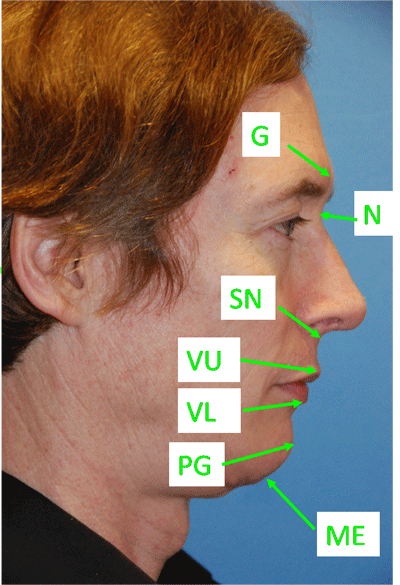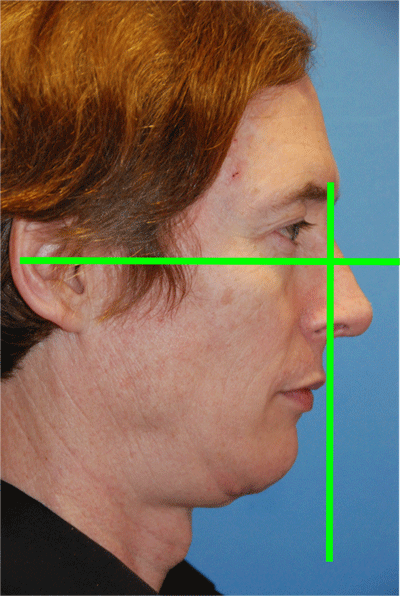Chin implants (Dr Young specializes in plastic surgery in the Face and Neck in Bellevue Washington) come in many shapes and sizes. Sometimes, even with the many variations there might not be one that fits all of your needs. This is when a custom implant may be the perfect choice for you. One of the first questions you should ask is whether or not a chin implant would work for you. There are multiple ways of assessing whether you could benefit from enhancing your chin. The first thing to do is to understand the various landmarks. In the first picture, the Glabella, labelled “G” is the most projecting point on the lower parto f the forehead and is usually right between the eyebrows. The nasion, labeled “N”, is the most depressed point below G and is usually at the root of the nose. The Subnasale, labeled “SN”, is the point of transition from the nose to the upper lip. It is where the nose, columnella, intersects the upper lip. The upper vermillion is the point of transition from the white part of the upper lip to the red portion of the lip (Called the Vermillion) and is labeled “VU”. The same point coinciding with the lower lip is labeled “VL”. The Pogonion, labeled “PG”, is the point of the chin that is the most projecting anteriorly. The mentum, labeled “MN”, is the most inferior portion of the chin. One thing to be careful of is when the patient has a double chin. The mentum is the part of the chin that is associated with the chin and not the inferior part of the sagging that can occur under the chin and posterior to the chin. One rule was developed by Gonzalez-Ulloa shown in the second picture. The horizontal line you see will be refered to a lot by surgeons. It is called the frankfort horizontal. It travels from the top of the ear canal and through the top of the inferior orbital rim. The vertical line you see is part of there interpretation of where the chin should be. The vertical line should travel through the Nasion and the the Pogonion should approximate this line. Some feel that the augmentation based on this rule would lead to too much projection. A similar rule places the vertical line of the Gonzalez-Ulloa line more posteriorly at the subnasale, although sometimes it is very close as in this picture, called the Epker and Fish Rule. Based on this rule, the vertical line should travel from the subnasale and through the upper vermillion “VU” and the lower vermillion should be 2mm behind, and the pogonion should be 4mm behind. The third really common rule is based on the Nasal Chin Lip Line. It is based on the ideal nasal length measure from the root of the nose at the level between the upper eyelid crease and the upper eyelid margin to the nasal tip. From the half point distance, a line is drawn through the upper lip vermillion. From this point, the pogonion should be be 3mm behind this line. The last two rules are my most preferred ways to assess how much chin augmentation to do. In another blog, I will address the vertical dimensional analysis.
Thanks for reading, Dr Young
Dr Young specializes in Facial Plastic and Reconstructive Surgery and is located in Bellevue near Seattle, Washington


